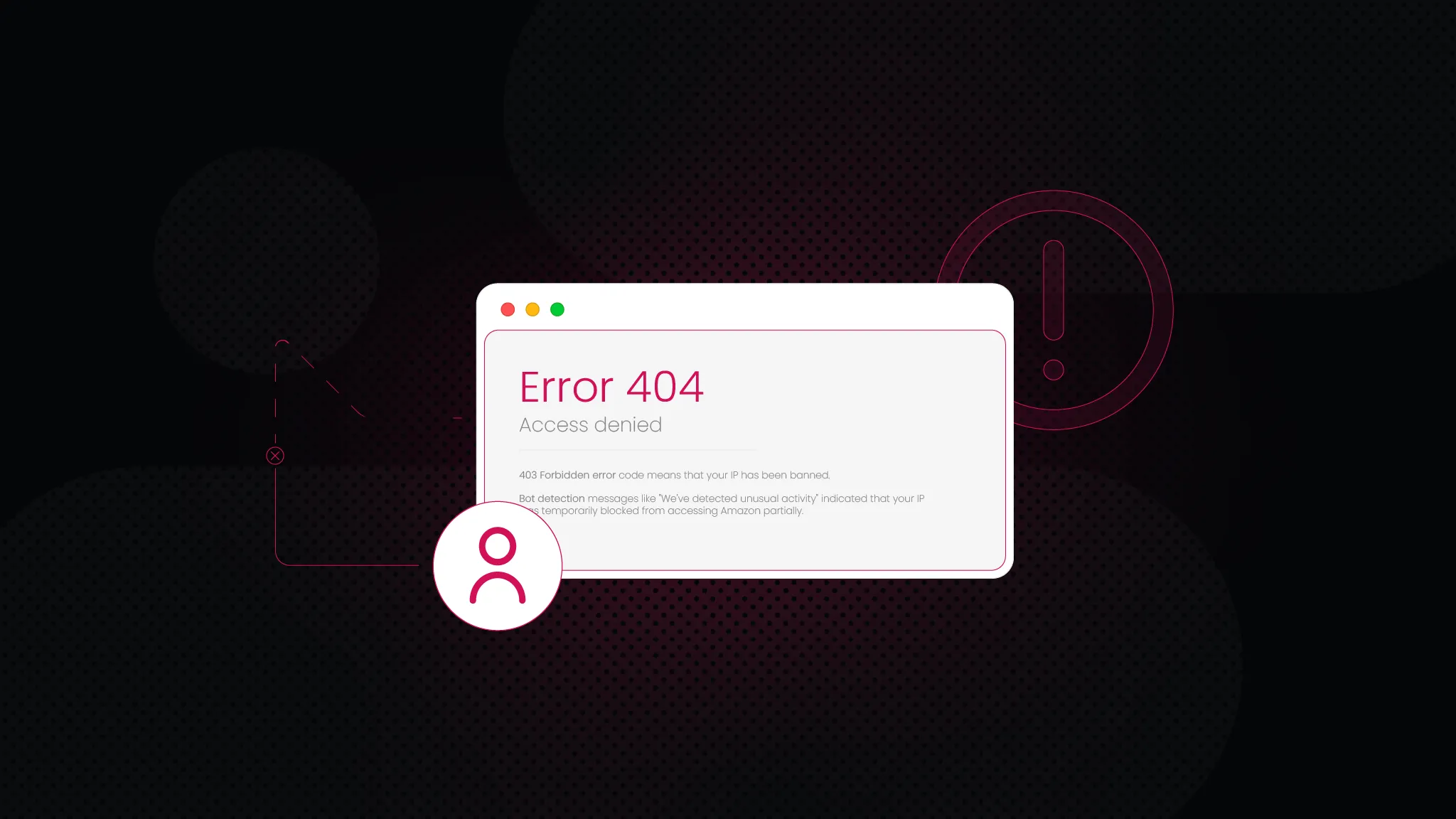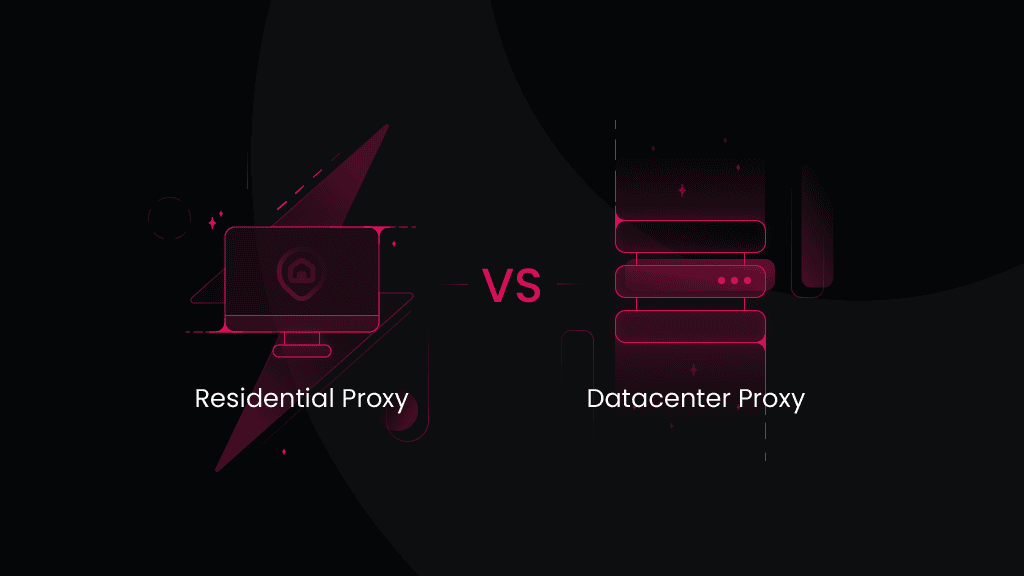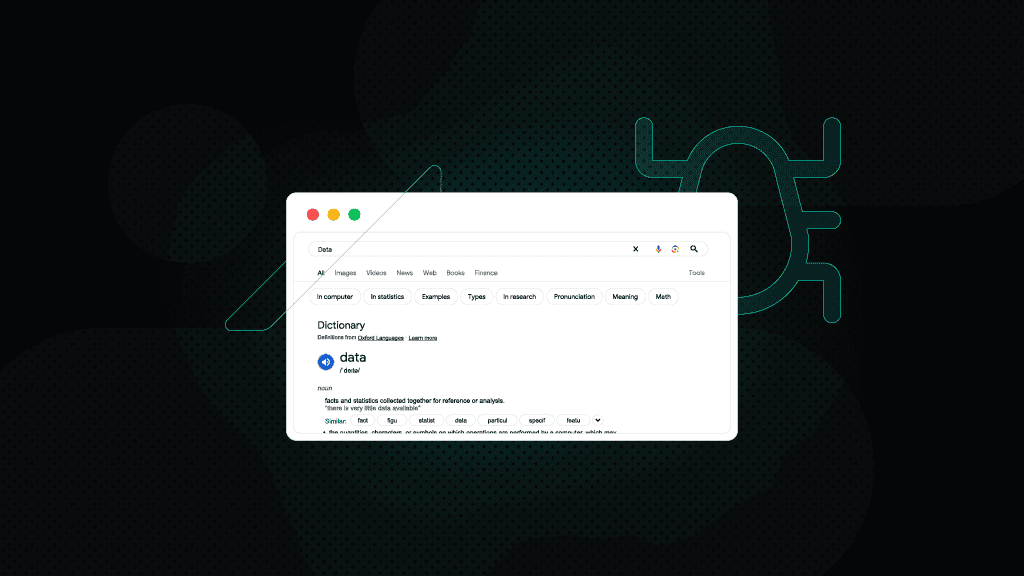Understanding Proxy Errors: Causes, Solutions, and How to Fix Them
Proxy errors like 404, 407, or 503 can be frustrating, but they’re clues to solving access issues. These HTTP codes indicate problems between your browser and the server. Whether it’s a client or server error, understanding the code helps you troubleshoot quickly. Let’s break down common proxy errors and find effective ways to fix them.
What is a proxy error?
Proxy errors, aka HTTP(S) error codes, are your server's way of communicating why a request failed when using proxy connections. These 3-digit codes reveal exactly where things went wrong—whether it's a client-side misconfiguration, server issue, or authentication problem.
These errors are helpful for developers and data teams working with web scraping or automation. They:
- Pinpoint failures in your proxy setup
- Guide troubleshooting with specific error classes (4xx vs. 5xx)
- Save debugging time by identifying authentication, timeout, or blocking issues
Common codes like 404 (Not Found) or 502 (Bad Gateway) aren't just roadblocks – they're diagnostic tools.

Residential proxies free trial
Get 3-day free trial of our residential proxies with #1 IP quality in the market.
Why do proxy errors happen?
In simple words, you've ended up with a proxy error code because the specific content can be reached only by a particular audience, and clearly, you're not on the VIP list. But shouldn't you get access to the restricted content because you already use proxies? The thing is that there's probably a problem with the adequate proxies’ management during crawling or scraping activities. Let's dig more into the types of proxy error codes and what problems they indicate.
Understanding HTTP status sode classes
Proxies can introduce 4xx/5xx errors by misrouting, timing out, or mishandling requests. You might face 4xx and 5xx status codes more often, so feel free to jump right to them if you are searching for them. If not, let's go straight to the proxy error codes.
HTTP status codes fall into five classes, with proxies often involved in errors:
Status code
What it means
1xx informational response
Provisional responses, proxies must forward them correctly.
2xx successful
Request succeeded, proxies shouldn't alter these.
3xx redirection
Requires further action, proxies must handle redirects properly to avoid loops.
4xx client error
Request issues (e.g., 403 Forbidden, 407 Proxy Auth Required), proxies may generate these if blocking or misconfiguring requests.
5xx server error
Server/proxy failures (e.g., 502 Bad Gateway, 504 Timeout), common when proxies fail to connect upstream or overload.
1xx – informational responses
These "waiting room" responses tell you the server is working on your request but isn't ready to reply yet. You'll rarely see them during normal browsing, but they're important for developers working with proxies and web scraping.
100 – continue
This code shows up when a part of the request has been received, and the user should proceed with the remaining submission. The initial request header should include Expect: 100-continue. After receiving a 100 error code, it's time to send the remaining request body. This way, you’ll avoid sending too many requests if the header is rejected in the "Expect" phase.
101 – switching protocols
The code indicates that the browser requested a switch in the communication protocol, and the server approved the request.
102 – processing (WebDAV)
If you see this one, you have probably made a request containing many sub-requests that take longer to complete. Don't assume that the request is lost – better to give your server more time to digest your complex request.
103 – early hints
Your server just took a well-deserved break. Who doesn't need that? While the web server hasn't started processing your request, you can still use your browser.
3xx – redirection status error
Status codes starting with 3 indicate that some additional action from your side is needed to comply with your request. These codes mean your request needs to take a detour. For web scraping and bot automation, understanding these is crucial to avoid infinite loops and failed requests.
301 – moved permanently
- What happens: the resource has a new permanent home.
- Scraping impact: update your target URLs or risk missing data.
- Expert fix: use advanced scraping APIs that automatically handle URL redirects.
302 – found (temporary redirect)
What happens: temporary relocation – check back at the original URL later.
- Proxy challenge: can trigger anti-bot systems if overused.
- Expert fix: implement randomized delay periods and IP rotation between requests.
304 – not modified
What happens: the content hasn't changed since your last request.
- Efficiency boost: Saves bandwidth by using cached versions.
- Expert fix: Pair with conditional requests (If-Modified-Since headers).
307/308 – temporary or permanent redirect
- Key difference: 307/308 preserve the original request method, for example, POST stays POST.
- Scraping gotcha: POST requests to 301/302 URLs often convert to GET. That is, When a POST request (used to send/submit data) hits a 301 (Permanent Redirect) or 302 (Temporary Redirect), many servers/clients will automatically convert it to a GET request (used to retrieve data) when following the redirect.
- Expert fix: use request interception to handle method preservation.
Why this matters for proxies
- Redirect chains slow down scraping and increase detection risk.
- Each redirect exposes more request metadata to target servers.
- Our session control helps maintain consistency through redirects.
To fix this, configure your scraper to follow a maximum of 3-5 redirects to avoid traps and timeouts. Both 307 and 308 are pretty similar to 301 and 302. However, the main difference is the HTTP method, which doesn't change with the new URL.
4xx – client error
As you may have already guessed, this type of code indicates a problem on the client side. If you're a user, there's not so much you can do, but if you're a website owner, make sure to avoid these – your SEO won't show great results if you leave 4xx codes unattended.
400 – bad request
This is a very generic status code that shows you that the server can't respond to your request, but the cause is not defined. There can be plenty of reasons why you end up with 400 codes. It may be syntax or incorrect formatting. Recheck your request and include the URL before trying one more time.
401 – unauthorized error
We bet you've met this security guard at least once while trying to access your social media accounts through another device. The code implies that some authorization is needed to fulfill the request.
403 – forbidden
This time, the server identified you but didn't allow you to enter the club. You can still end up there, you just need to change your proxy location or ports. Check if your proxy is working correctly to be 100% sure that this code won't pop up on your screen again.
404 – not found
Probably the most common and, let me guess, the most annoying one. The "Not found" error code means that the website you're trying to reach doesn't exist. Crawlers or bots can't get to the site even if your initial request is correct. If you end up with 404, the URL is incorrect, changed, or just removed. This error code especially catches SEO specialists' attention since it can hurt the health of the page quite a lot. Even though 404 is super-annoying, to some people, it turned out to be an excellent opportunity to grow revenue while increasing organic traffic.
407 – proxy authentication required
You guessed it right – some proxy authentication is needed to perform the request. Most probably, the username or password is incorrect. The code occurs when the crawler does not have the proxy provider, or the IP hasn't been whitelisted. The easy solution is to cross-check your proxy settings by including all the IPs you're planning to use, enter proper credentials, and include the requested information to proceed.
408 – request timeout
The site you're reaching out to didn't respond to a request in time, so the server has timed out. Slow internet can cause such a situation, so try to refresh the page. If this isn't the case, try changing the session type or endpoint.
414 – URI too long
The server is unwilling to proceed with your request since the URI is too long. It can also indicate that the server is suffering an attack, aiming to identify the potential security holes.
429 – too many requests
This proxy error code shows that the same IP address has already made too many requests during the period. In other words, your behavior starts reminding the bot rather than a single individual. Luckily, we have an easy solution for this – using rotating proxies will help you to get a new IP with every connection.
You can fix 407, 414, and other 4xx errors by using proper authentication headers and checking proxy access rules first.
5xx – server error
Number five clearly states that the problem is on the server's side. Everything is fine with your request, your call was placed on the server successfully, it just didn't pick up the dial due to internal issues. In this situation, you can try rotating IPs or changing their type. To minimize such proxy errors, use residential proxies. They're more reliable in this case.
500 – internal server error
The server stopped responding due to an internal bug. Try the request a bit later.
501 – not implemented
The server can't recognize your requesting methods and can't fulfill your submission correctly. In this case, there's not much you can do except contact your server to fix the issue. But before that, of course, try to reload the page and clear the cache.
502 – bad gateway
If you're not a newbie in the proxies world, you have probably faced this one at least once. It sometimes happens during data scraping, when the server acts as a proxy to another server and receives an invalid response from another server. Probably the connection was disrupted, or it has been spotted as a bot. The quick solution is to rotate the IP.
However, if you're using datacenter proxies, this may not help. It's possible that the site you are reaching blocks datacenter proxies since they're easier to recognize. If this is the case, try to switch to the proxy type that has a higher authenticy rate, for example residential proxies or static residential (ISP) proxies.
503 – service unavailable
The server is overloaded or under maintenance and cannot process your request. Usually, it's a temporary issue, so try connecting later.
504 – gateway timeout
This code pops up when the server acting as a proxy or gateway can't deliver the results to another server on time. Check your server connection and retry your request.
505 – HTTP version not supported
This one is pretty self-explanatory – your request doesn't match the HTTP protocol version. Therefore, the server can't respond to your request.
511 – network authentication required
This proxy error code means that you need to authenticate your network to receive a response. It can be related to the accepting terms, for example, while trying to connect to WiFi at the airport.
522 – connect timeout
The proxy connection timeout, so you need to reconnect again. The easiest fix for 504, 522, and other 5xx error codes is to route traffic around the proxy and updating your DNS.
How to solve proxy errors?
Proxy error codes help you indicate the problem and search for specific solutions. When the code is triggered, the most popular solution is to repeat the request, switch IP, check the connection, and simply change the network. There is no perfect pill for every error, but these could be the first steps you should try.
- Identify the error code – check HTTP status code (client-side or server/proxy-side) and review proxy & backend logs.
- Test direct access – bypass the proxy to isolate the issue.
- Verify proxy configuration – check timeouts, ACLs, routing rules, and restart proxy services.
- Inspect headers & authentication – use verbose logging and ensure required headers (User-Agent, Authorization) are included.
Error-specific fixes
To solve 4xx errors:
- 400 – fix malformed headers/URLs or incorrect HTTP methods.
- 403 – whitelist client IP or adjust proxy ACLs.
- 407 – add proxy auth credentials.
- 429 – reduce request rate or increase proxy rate limits.
To fight back the 5xx errors:
- 502 – ensure backend is running; increase proxy timeouts.
- 503 – scale backend servers or disable maintenance mode.
- 504 – optimize slow backend responses, raise proxy_connect_timeout.
For all errors, check proxy logs and test direct backend access first.
Improve proxy use
Optimizing your proxy setup can significantly improve your browsing and web scraping experience and help you bypass common proxy-related errors. Here are some practical tips to elevate your proxy game and keep things running smoothly.
Try different types of proxies
A pretty obvious solution, but this may be your golden ticket. We love datacenter proxies because of their speed and stability, but they're easier to recognize by servers. To make your browsing more human-like, use residential proxies. The big chances are that you'll stop getting 502 proxy error codes, and the general user experience will be better.

Residential proxies with 3-day free trial
Get a 100MB test-drive of our awarded proxies and leave proxy errors, CAPTCHAs, and IP bans behind.
Increase the delay between requests
Give the server some breathing room by increasing the time between your requests. This simple adjustment can prevent overloading the system and reduce the chances of getting blocked. Slower, more spaced-out requests mimic human behavior, making them less likely to trigger automated defenses. Plus, it’s just good digital etiquette to let the server catch its breath.
Improve IP rotation
A simple yet effective solution is to avoid sticking with one IP address for too long. Frequent IP changes reduce the risk of being restricted or blocked, especially when making numerous requests. The good news? We offer advanced proxy rotation to seamlessly switch between multiple IP addresses, enhancing anonymity and maintaining uninterrupted access.
And for an even smoother and more convenient setup, take advantage of your Chrome Proxy Extension and Firefox Add-on. It streamlines the proxy configuration process, allowing you to integrate IP rotation effortlessly and keep your operations running without a hitch.
Still not sure how to fix the proxy error issue?
This ultimate guide aims to help you resolve proxy errors, providing a clear starting point when encountering these three-digit codes. However, if the proxy errors continue to pop up while using our solutions, we recommend exploring our extensive documentation or contacting 24/7 tech support via LiveChat – we'll help you to solve all errors!
About the author

Kipras Kalzanauskas
Senior Account Manager
Kipras is a strategic account expert with a strong background in sales, IT support, and data-driven solutions. Born and raised in Vilnius, he studied history at Vilnius University before spending time in the Lithuanian Military. For the past 3.5 years, he has been a key player at Smartproxy, working with Fortune 500 companies in eCommerce and Market Intelligence.
Connect with Kipras on LinkedIn.
All information on Smartproxy Blog is provided on an as is basis and for informational purposes only. We make no representation and disclaim all liability with respect to your use of any information contained on Smartproxy Blog or any third-party websites that may belinked therein.










